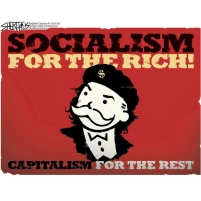Federal Reserve Finally Forced to Reveal What it Did with $3.3 Trillion
Friday, December 03, 2010
 (graphic: John Sherifius)
(graphic: John Sherifius)
For two years, politicians and the media have been expressing opinions about the $700 billion set aside for the “Wall Street Bailout” by the Treasury Department and about the bailouts of mortgage enterprises Fannie Mae and Freddie Mac. But that was just pocket change compared to the real multi-trillion-dollar bailout that was handled by the Federal Reserve.
The board of governors of the Fed fought hard to keep secret what they did with those trillions, but thanks to the efforts of Sen. Bernie Sanders (I-Vermont) and others, some of the details have finally been made public.
While not providing all of the information regarding its efforts to rescue banks and large companies during the 2008 crisis, the Federal Reserve has released a database that shows how it allocated $3.3 trillion in loans. The move was prompted by a new law (Dodd-Frank) passed in July that was designed to make the central bank’s operations more transparent. It was Sanders who sponsored the amendment to the law that forced the disclosures.
The enormous amount of lending benefited teetering Wall Street powerhouses, large American corporations and some of Europe’s most significant financial institutions.
Goldman Sachs turned to the Fed 84 times to borrow nearly $600 billion, and Morgan Stanley made 212 visits for emergency loans. Other major U.S. financial institutions that borrowed multiple times were Citigroup (26 times), MetLife Bank (19 times), Bank of America (15 times) and JPMorgan Chase (seven times).
European banks were the largest beneficiaries of the Fed’s purchase of mortgage-backed securities. Deutsche Bank of Germany was able to sell the Fed more than $290 billion worth of mortgage securities, while Switzerland-based Credit Suisse dumped $287 billion in mortgage bonds. Barclays Capital, the investment bank of U.K. lender Barclays PLC ($123 billion), UBS of Switzerland ($94 billion), and BNP Paribas of France ($67 billion) also took advantage of the Federal Reserve’s generosity.
Corporate recipients of Fed assistance included General Electric, Chrysler Financial Services, AIG, McDonalds, Verizon and Harley-Davidson.
The $3.3 trillion figure did not include lending to banks through the Fed’s discount window. That information remains confidential and the subject of an ongoing lawsuit by media companies seeking to publish details of that aspect of the 2008 crisis.
According to Sen. Sanders, “Among the corporate beneficiaries were Citigroup, which received over $1.8 trillion; Morgan Stanley, which received nearly $2 trillion; Goldman Sachs, which received nearly $600 billion; and Bear Stearns, which received more than $960 billion in short-term loans with an interest rate as low as 0.5 percent.” This money was all loaned at zero or near-zero interest.
In addition, General Electric received $16 trillion in short-term financing under a “commercial paper funding facility” that purchased both asset-based and unsecured loans for three-month periods.
-David Wallechinsky, Noel Brinkerhoff
Fed Data Show Firms on the Brink (by Luca Di Leo and Maya Jackson Randall, Wall Street Journal)
Fed Opens Books, Revealing European Megabanks Were Biggest Beneficiaries (by Shahien Nasiripour, Huffington Post)
Fed's 'Backdoor Bailout' Provided $3.3 Trillion in Loans to Banks, Corporations (by John Nichols, The Nation)
Fed Disclosure Lifts Veil of Secrecy, Sanders Says (press release, Sen. Bernie Sanders)
Senate Rejects Regular Audits of Federal Reserve (by Noel Brinkerhoff and David Wallechinsky, AllGov)
Americans Support Ron Paul Plan to Audit the Federal Reserve (by Noel Brinkerhoff, AllGov)
- Top Stories
- Unusual News
- Where is the Money Going?
- Controversies
- U.S. and the World
- Appointments and Resignations
- Latest News
- Musk and Trump Fire Members of Congress
- Trump Calls for Violent Street Demonstrations Against Himself
- Trump Changes Name of Republican Party
- The 2024 Election By the Numbers
- Bashar al-Assad—The Fall of a Rabid AntiSemite






Comments